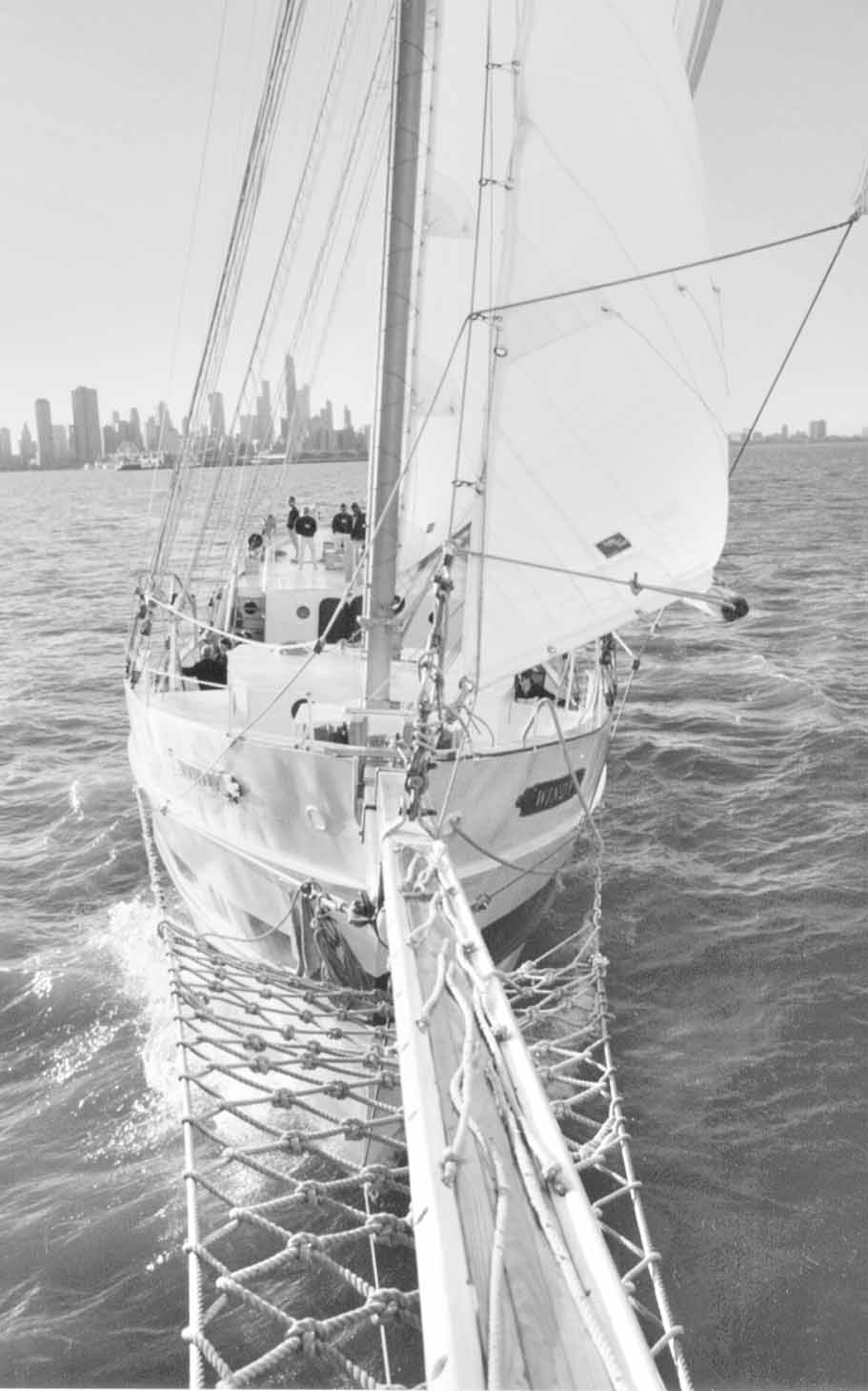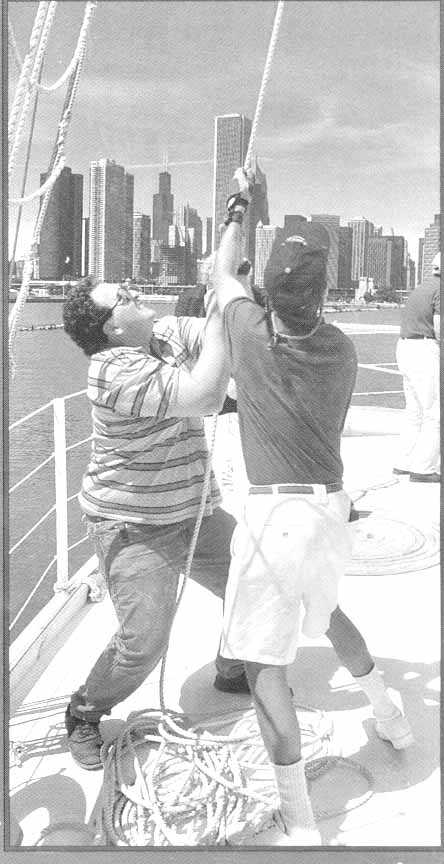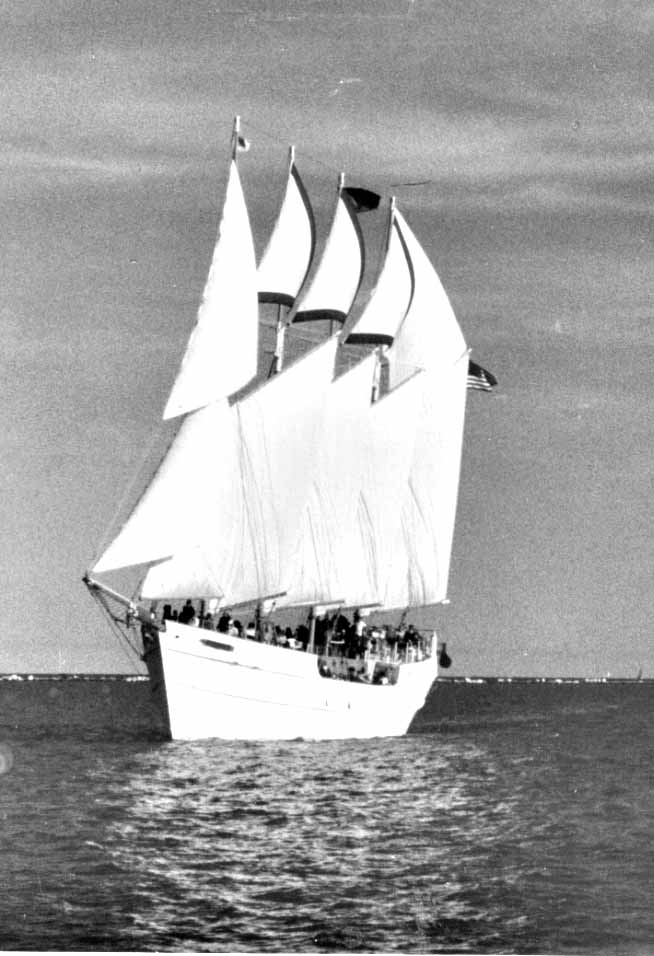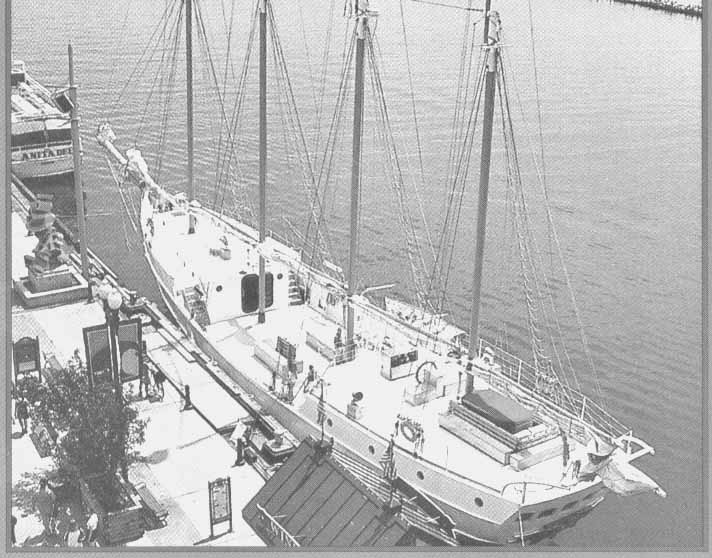Sailing Chicago’s Tall Ship
By Benjamin Neal
 Since 1996 Chicago sailors have become used to the unusual sight (at least in the last 75 years) of a traditional four masted tall ship cruising along the Lake Michigan harbors, and next year this notable vessel will be joined by a twin sister. Chicago is home to a great variety of craft, sail and power. The city sports plenty of cruisers, a number of fast race boats, and along with the usual urban contingent of skyline tours and dinner cruises. The schooner Windy, stands out unmistakably from the rest of the fleet. She is currently the largest sailing vessel on Lake Michigan, and the only sizable gaff rigged sailing craft left in a port that in the late 1800s received as many as 20,000 trading schooners a year.
Since 1996 Chicago sailors have become used to the unusual sight (at least in the last 75 years) of a traditional four masted tall ship cruising along the Lake Michigan harbors, and next year this notable vessel will be joined by a twin sister. Chicago is home to a great variety of craft, sail and power. The city sports plenty of cruisers, a number of fast race boats, and along with the usual urban contingent of skyline tours and dinner cruises. The schooner Windy, stands out unmistakably from the rest of the fleet. She is currently the largest sailing vessel on Lake Michigan, and the only sizable gaff rigged sailing craft left in a port that in the late 1800s received as many as 20,000 trading schooners a year.
The schooner Windy, was built in 1996 specifically for running sails from the new Navy Pier entertainment complex. She was designed, built, and is still operated by Capt. Bob Marthai, an independent and multifaceted character who has been a college professor of psychology and Chicago bus driver as well as a traditional boat builder and captain. He built his first boat (a 21 foot cruiser) as a high school shop project at age 17, and sailed it a thousand miles home. Over the years he has also built and operated two other smaller steel schooners. Until recently he had been running the Windy with the able help of his two feisty, redheaded daughters Sonya and Nikki, with his wife Janine holding down the busy office. This year he has turned the boat over to Capt. John Deely, a professional captain specializing in traditional sail, and turned his attentions to creating a second boat, the Windy II. This second boat will be built to the same design as the first, and in the same yard in South Carolina (Detyens of Charleston). The original Windy took 17 months to complete, a figure Bob hopes to get down to 10 months this time. 
Windy is not a strict reproduction of any particular traditional type, but rather an amalgamation of design elements brought together to create a platform to get people out on the water and experiencing historical sailing; "This is a hybrid educational vessel designed to provide safety and to take the public out on tours. Our interest is the heritage of the experience," notes Marthai. He has incorporated several modern materials and features into her traditional appearance. She is the first four masted schooner built in the US since 1921, but has a steel hull and deck, where those older vessels would have been wood. Windy is 148' in length overall (including an almost 25' long wooden bowsprit), 109' length on deck, and she displaces 188 tons. The masts are aluminum, rising 88 feet off the water, round in section with a 3/4" wall thickness, and booms and gaffs are built of laminated wood. The four lower sails are traditionally gaff rigged, but the topsails depart from history in that they have roller furling, eliminating the need to go aloft each time they are struck. She flies up to three headsails, with the outermost, the jib topsail, being flown only in very light air. Altogether she can set about 5,000 square feet on a total of 11 sails. She is run by a crew of five, the captain and four deckhands, with participation by passengers welcomed in setting and furling the sails, or taking a turn at the helm. Windy II will carry squaresails on her foremast, technically making her a barquentine. The underwater profile departs radically from wooden design with a large wing keel made from a 30,000 pound steel plate shoe, which reduces her draft to only 8 feet.. 1700 gallons of diesel, 2400 gallons of fresh water, and 1700 gallons of waste tankage are all down in the hollow keel, contributing to the ballast, in addition to an additional 30,000 pounds of loose steel. She is pushed by a single screw and a 300 horsepower Cummins diesel, and has a hydraulic bowthruster for ease of docking at crowded Navy Pier. Steering is manual, through a traditional worm gear. The boat is Coast Guard inspected, and licensed for 150 people for daysails, and 26 for overnight. Below decks she has eight double cabins, four heads, and a forecastle with 12 bunks. Most of the after part of the boat is a large great cabin, providing a generous dining and gathering space. For chartered trips the food is usually brought in by caterers, but there is also a complete galley for food preparation underway on longer trips.
 This is a fun boat to sail, but certainly not the kind of boat to put through the buoys with your club on a breezy Saturday afternoon (although there is some appeal to the notion of a fleet of 10 or 15 huge schooners, all vying for a windward mark, like going to the elephant races). She needs a fresh breeze to get moving well, but in 30 knots of wind, has been known to hit 10 or 11 knots. (Don't hold your breath for her to get up on plane.) Capt. John has been known, in perfect conditions, to sail her on and off the dock, and the variety of sails allows for a good number of rig and balance options. If you find yourself at the helm, remember that 188 tons takes a long time to tack, so think ahead by about two minutes.
This is a fun boat to sail, but certainly not the kind of boat to put through the buoys with your club on a breezy Saturday afternoon (although there is some appeal to the notion of a fleet of 10 or 15 huge schooners, all vying for a windward mark, like going to the elephant races). She needs a fresh breeze to get moving well, but in 30 knots of wind, has been known to hit 10 or 11 knots. (Don't hold your breath for her to get up on plane.) Capt. John has been known, in perfect conditions, to sail her on and off the dock, and the variety of sails allows for a good number of rig and balance options. If you find yourself at the helm, remember that 188 tons takes a long time to tack, so think ahead by about two minutes.
Windy's mission is varied, with the goal being to introduce as many people as possible to a big boat sailing experience while still staying afloat financially. Thus she is available for private or corporate charter, and runs daysails with folks walking by on Navy Pier, as well as doing sail training and nautical science education for student and youth groups. Capt. Marthai especially enjoys bringing the history and experience of traditional sailing to younger folks, and offers greatly reduced rates for these types of groups. In the last three years the boat has sailed up and down the Great Lakes, the east coast, and has spent a winter working in the Virgin Islands. While voyaging she often takes on week-long passengers as well. The second boat is expected to spend more of i's time doing these sorts of passages, traveling back and forth from Chicago to Charleston, S.C., and participating next season in the Tall Ships 2000 festivities. Capt. Marthai's overall goal is to bring people of all backgrounds to the water, to have them feel the press of wind on the sails, and to help them connect with America's maritime past, even if it is only for a short afternoon
daysail.
forth from Chicago to Charleston, S.C., and participating next season in the Tall Ships 2000 festivities. Capt. Marthai's overall goal is to bring people of all backgrounds to the water, to have them feel the press of wind on the sails, and to help them connect with America's maritime past, even if it is only for a short afternoon
daysail.
Windy and Windy II can be contacted by interested groups or individuals at 600 E. Grand Ave., Navy Pier, Chicago, IL, 60611, (312) 595-5555 or (312) 595-5472.
Ben Neal lives in Hayward, Wisconsin and sails out of Ashland when not working on traditional vessels.
Back to Articles
About Sailing Breezes Magazine
Please send us your comments!!
All contents
are copyright (c) 1999
by Northern Breezes, Inc. All information contained within is deemed reliable but carries
no guarantees. Reproduction of any part or whole of this publication in any form by
mechanical or electronic means, including information retrieval is prohibited except by
consent of the publisher.
 Since 1996 Chicago sailors have become used to the unusual sight (at least in the last 75 years) of a traditional four masted tall ship cruising along the Lake Michigan harbors, and next year this notable vessel will be joined by a twin sister. Chicago is home to a great variety of craft, sail and power. The city sports plenty of cruisers, a number of fast race boats, and along with the usual urban contingent of skyline tours and dinner cruises. The schooner Windy, stands out unmistakably from the rest of the fleet. She is currently the largest sailing vessel on Lake Michigan, and the only sizable gaff rigged sailing craft left in a port that in the late 1800s received as many as 20,000 trading schooners a year.
Since 1996 Chicago sailors have become used to the unusual sight (at least in the last 75 years) of a traditional four masted tall ship cruising along the Lake Michigan harbors, and next year this notable vessel will be joined by a twin sister. Chicago is home to a great variety of craft, sail and power. The city sports plenty of cruisers, a number of fast race boats, and along with the usual urban contingent of skyline tours and dinner cruises. The schooner Windy, stands out unmistakably from the rest of the fleet. She is currently the largest sailing vessel on Lake Michigan, and the only sizable gaff rigged sailing craft left in a port that in the late 1800s received as many as 20,000 trading schooners a year. 
 This is a fun boat to sail, but certainly not the kind of boat to put through the buoys with your club on a breezy Saturday afternoon (although there is some appeal to the notion of a fleet of 10 or 15 huge schooners, all vying for a windward mark, like going to the elephant races). She needs a fresh breeze to get moving well, but in 30 knots of wind, has been known to hit 10 or 11 knots. (Don't hold your breath for her to get up on plane.) Capt. John has been known, in perfect conditions, to sail her on and off the dock, and the variety of sails allows for a good number of rig and balance options. If you find yourself at the helm, remember that 188 tons takes a long time to tack, so think ahead by about two minutes.
This is a fun boat to sail, but certainly not the kind of boat to put through the buoys with your club on a breezy Saturday afternoon (although there is some appeal to the notion of a fleet of 10 or 15 huge schooners, all vying for a windward mark, like going to the elephant races). She needs a fresh breeze to get moving well, but in 30 knots of wind, has been known to hit 10 or 11 knots. (Don't hold your breath for her to get up on plane.) Capt. John has been known, in perfect conditions, to sail her on and off the dock, and the variety of sails allows for a good number of rig and balance options. If you find yourself at the helm, remember that 188 tons takes a long time to tack, so think ahead by about two minutes. forth from Chicago to Charleston, S.C., and participating next season in the Tall Ships 2000 festivities. Capt. Marthai's overall goal is to bring people of all backgrounds to the water, to have them feel the press of wind on the sails, and to help them connect with America's maritime past, even if it is only for a short afternoon
daysail.
forth from Chicago to Charleston, S.C., and participating next season in the Tall Ships 2000 festivities. Capt. Marthai's overall goal is to bring people of all backgrounds to the water, to have them feel the press of wind on the sails, and to help them connect with America's maritime past, even if it is only for a short afternoon
daysail.